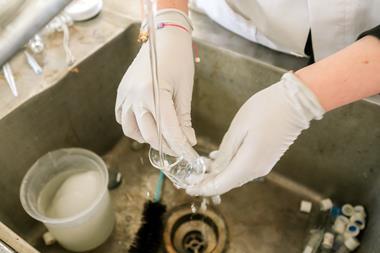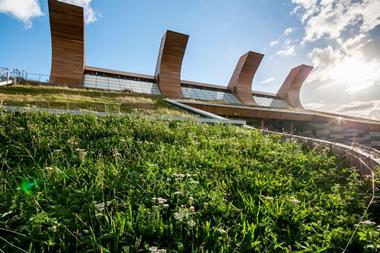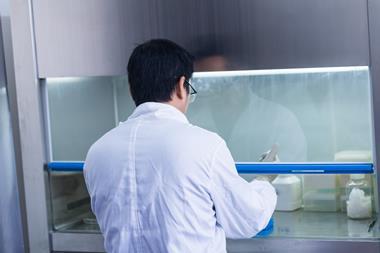Scientific organisations like mine champion the role of R&D in rising to sustainability challenges. We highlight how discoveries and applications, involving multiple disciplines and sectors, have been key in everything from the unprecedented roll-out of Covid -19 vaccines and diagnostics to the fact that wind and solar are now the cheapest option for new power generation in many countries.
But what about the environmental footprint of research? And what do researchers think about this? What changes are people making?
These are some of the questions we started to explore last year. We’ve published our findings in our Sustainable Labs report, which references many initiatives and resources that already exist to support researchers in reducing the climate, pollution and biodiversity impacts of wet lab, dry lab and computational research.
In our survey, 90% of researchers agreed that it is important to consider environmental sustainability in their day-to-day laboratory work. 63% are already making changes and 84% want to do more. Respondents cited obstacles like lack of time, money, expertise or data, as well as cultural, systemic and technical barriers. We also heard thought-provoking ideas about the roles and responsibilities of individual scientists, as well as the complexity and trade-offs inherent in achieving the interconnected environmental, social and economic dimensions of sustainability.
These perspectives include a feeling that there is no point in doing anything because the scale of environmental issues is so great that the actions of one individual or lab will make no difference. Or that the sustainability gains from research – new therapeutics, catalysts or battery materials – exceed those that might flow from changing how a lab operates. The logic then is that it is best to focus on getting results.
Squaring the sustainability benefits of an activity with its environmental impacts is something that organisations everywhere are grappling with. How does a university weigh its contributions to achieving the Sustainable Development Goals against its own environmental impacts? Or how do organisations balance efforts to eliminate malaria or cancer against the fact that life sciences research generates around 2% of single-use plastics waste?
These questions are, I think, unanswerable in any absolute or objective way but I have found that reflecting on them is useful in renewing a sense of the purpose and value of Stem. In a way they ‘keep us honest’ in our claims about its impacts and importance. They help us ensure that our narratives about the value of science are relevant in the context of contemporary environmental, societal, economic and political realities. Discussing them can challenge and expand our thinking about what solutions may be needed or possible.
I talk a lot with practising scientists and my sense is that most genuinely want their work to make a difference. They care about the next generation of scientists and citizens. They are working on important research problems, from advancing our fundamental understanding of our world to capturing carbon dioxide or combatting antimicrobial resistance.
For those scientists that are sceptical about going greener in the lab, here are 12 reasons to engage with this agenda:
1 Doing the right thing: For some people it’s simply about doing what they can to reduce their personal and professional environmental footprint
2 Small things add up: Most labs have a comparatively small environmental footprint, but each one contributes to the total (UNESCO estimates there are 8 million researchers). Making changes gives personal agency and accepts a part of collective responsibility.
3 Walking the talk: Experts engaging with the public or policymakers on environment, safety or health need to be confident their own practices are consistent with what they are saying.
4 Saving money: Initiatives that reduce consumption of energy, water and materials, or production of waste, often mean net cost reductions long-term.
5 Talent and passion: Consistency with values on issues like environment and equality can tip the balance for students and employees choosing the work they do and who to work for.
6 Green investment: Investors in start-ups and corporates, as well as government and charitable funders, are increasingly factoring sustainability credentials into their decisions.
7 Shaping solutions: By being proactive and engaging, researchers can make sure that organisational, supplier or funder sustainability solutions are best for science too.
8 New opportunities: Green labs require multi-disciplinary innovation and create opportunities for new business and new research.
9 Efficiency: It makes no sense for each researcher or lab to figure everything out from scratch. Co-developing resources and strategies will save everyone time and money.
10 Accessibility: Sharing tools and expertise with researchers in resource-limited situations will enable more people to reduce the footprint of their labs.
11 Advocacy: Coordination enables a stronger collective scientific voice when needed within organisations or with external suppliers, regulators or funders.
12 Stubborn optimism: The scale of environmental or social challenges is so daunting that people can give up. I like the idea of stubborn or impatient (as opposed to naïve) optimism, which I first heard in Christiana Figueres’ inside story of the Paris climate change agreement.
I don’t expect every scientist to agree with all of these reasons, but I hope that many are compelling counterpoints to the more doubtful perspectives above. And for those who do not need convincing themselves, being aware of these diverse motivations can be useful when influencing peers, bosses or organisations.
My colleagues and I hope that the information and examples in our report will be useful for those newer to the idea of green labs. We welcome feedback and ideas about how the RSC can work with the community and partners to enable scientists to discover and innovate sustainably, in the holistic people-planet-prosperity sense of the word.












No comments yet